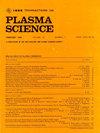交流和纳秒脉冲激励下环形表面介质阻挡放电特性的比较
IF 1.5
4区 物理与天体物理
Q3 PHYSICS, FLUIDS & PLASMAS
引用次数: 0
摘要
为了探索环形表面介质阻挡放电(SDBD)的放电特性,指导等离子体激励源的优化,本研究对高频高压交流电源(ac)和纳秒脉冲电源驱动下的环形表面介质阻挡放电(SDBD)行为进行了对比分析。利用电压-电流波形和放电图像系统地研究了两种激励模式下放电起始、空间形态和时间演变的差异。结果表明,纳秒脉冲SDBD在电压下降阶段表现为反向放电,而交流驱动SDBD由于累积表面电荷效应而表现为提前放电。随着电压幅值的增加,两种激励方式均产生更多的流道和更宽的放电区域。但是,它们的放电分布方式有很大的不同。在交流激励下,环形SDBD产生沿高压电极边缘的丝状放电,而在纳秒脉冲激励下,产生分离通道放电通道。这些差异归因于电压上升时间和表面电荷动力学的变化。纳秒脉冲产生更强的瞬态电场,扩大放电范围。在ac-SDBD中,高压电极附近的残余电子促进下一个循环的早期击穿。相反,脉冲激励下的反向放电减少了剩余正电荷并延迟了下一次放电。然而,已建立的通道的高导电性促进了在同一位置的重复击穿,保持了分开的通道分布。本文章由计算机程序翻译,如有差异,请以英文原文为准。
Comparison of Annular Surface Dielectric Barrier Discharge Characteristics Under AC and Nanosecond Pulsed Excitation
To explore the discharge characteristics of annular surface dielectric barrier discharge (SDBD) and guide the optimization of plasma excitation sources, this study presents a comparative analysis of SDBD behavior driven by a high-frequency, high-voltage alternating current (ac) power supply and a nanosecond pulsed power supply. The voltage–current waveforms and discharge images were employed to systematically investigate the differences in discharge initiation, spatial morphology, and temporal evolution under the two excitation modes. The results show that nanosecond-pulsed SDBD exhibits reverse discharge during the voltage fall phase, whereas ac-driven SDBD exhibits an earlier discharge onset due to cumulative surface charge effects. As the voltage amplitude increases, both excitation modes produce more streamer channels and broader discharge areas. However, their discharge distribution modes differ significantly. Annular SDBD under ac excitation produces filamentary discharge localized along the edge of the high-voltage electrode, whereas under nanosecond pulse excitation, the separated-channel discharge channels are produced. These differences are attributed to variations in voltage rise time and surface charge dynamics. Nanosecond pulses create a stronger transient electric field, expanding discharge coverage. In ac-SDBD, residual electrons near the high-voltage electrode promote early breakdown in the next cycle. In contrast, reverse discharge under pulsed excitation reduces residual positive charge and delays the next discharge. Nevertheless, the high conductivity of established channels promotes repeated breakdown in the same location, maintaining separated-channel distribution.
求助全文
通过发布文献求助,成功后即可免费获取论文全文。
去求助
来源期刊

IEEE Transactions on Plasma Science
物理-物理:流体与等离子体
CiteScore
3.00
自引率
20.00%
发文量
538
审稿时长
3.8 months
期刊介绍:
The scope covers all aspects of the theory and application of plasma science. It includes the following areas: magnetohydrodynamics; thermionics and plasma diodes; basic plasma phenomena; gaseous electronics; microwave/plasma interaction; electron, ion, and plasma sources; space plasmas; intense electron and ion beams; laser-plasma interactions; plasma diagnostics; plasma chemistry and processing; solid-state plasmas; plasma heating; plasma for controlled fusion research; high energy density plasmas; industrial/commercial applications of plasma physics; plasma waves and instabilities; and high power microwave and submillimeter wave generation.
 求助内容:
求助内容: 应助结果提醒方式:
应助结果提醒方式:


